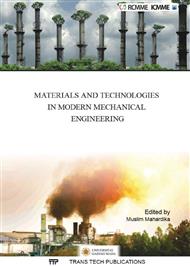p.3
p.7
p.14
p.19
p.24
p.31
p.36
p.43
p.53
Development of a Methodology for Assessing the Energy Efficiency Performance on Turning Processes
Abstract:
This paper aimed to develop a methodology for assessing environmental friendliness of turning processes from energy consumption’s perspective. This methodology was limited on the process level study, which turning process was chosen as the assessed process. Recently, the green manufacturing has become a very important matter due to environmental impacts caused by manufacturing processes. Reducing the amounts of input energy or increasing efficiencies of production equipment’s can help to achieve the green manufacturing level, but it does not indicate the level of energy consumption. Therefore, a methodology is needed to determine how green a manufacturing process on energy consumption’s perspective. In this case, an energy indicator can be used to evaluate the energy usage performance. Based on the experimental data from several different machines, regression lines is constructed (using data envelopment analysis) as the efficiency reference values. According to the position of the energy efficiency from the assessed process to the efficiency reference values, it will determine whether the process has a high or low efficiency (as the assessment result). This methodology has tried to indicate the level of energy consumption, by comparing the result from energy indicator with the reference value. Energy indicator for material removing processes is commonly used to predict the total energy consumption for energy assessment without comparing the result to the reference value.
Info:
Periodical:
Pages:
19-23
Citation:
Online since:
June 2016
Price:
Сopyright:
© 2016 Trans Tech Publications Ltd. All Rights Reserved
Share:
Citation:


